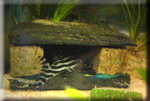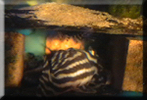Breeding
The following section is an account of my own personal experiences in breeding this wonderful fish. For more details please look through some of the submitted articles, or visit the forum.
The Conditions There doesn't seem to be any definite science to breeding Hypancistrus zebra, so it is not always necessary to get the water parameters exact. Apart from good water, it is essential to have plenty of caves for the fish to hide, form territories, and of course spawn. The caves can be made from crevices in rocks, bits of plasic pipe - dark in colour), slate, or in my case, slate boxes held togther with aquatic silcone (cheers Des). The height of these caves should fit the male zebra snuggly, when his dorsal fin if fully extended.
There doesn't seem to be any definite science to breeding Hypancistrus zebra, so it is not always necessary to get the water parameters exact. Apart from good water, it is essential to have plenty of caves for the fish to hide, form territories, and of course spawn. The caves can be made from crevices in rocks, bits of plasic pipe - dark in colour), slate, or in my case, slate boxes held togther with aquatic silcone (cheers Des). The height of these caves should fit the male zebra snuggly, when his dorsal fin if fully extended.
A high flow rate is required, as the Zebras are used to a high current in the wild. This will also ensure that the fish are well fed. i.e. high filtration ensures the water does not become polluted.
Breeding season is thought to be around July to September - although this can be induced at any time in captivity). The zebras spawn during rainy season, which can invariably reduce the water temperature slightly. I try and simulate this by doing a 30% water change, dropping the temp from 84 to 80°C. Then I turn off the heater for about 2 hours until the temp reaches about 76. I then let the temp build back up to about 82.
The water parameters can vary, but here are the ones that I have had success with, - averaged out with those from PlanetCatfish.
| Temperature | pH | Gh | Kh | Nitrites | Nitrates |
| 80 - 82 - to condition) 84 - 86 - For Breeding) | 6.3 - 6.8 | 5 - 8 | 4 - 6 | 0 | 5ml/l |
The above figures are meant as a guide, further details are available on our Stats page.
The Activity The first sign of activity is the female moving about the entrance of the males cave. The male will guard the entrance at this point. This may carry on for anywhere between an hour or a day.
The first sign of activity is the female moving about the entrance of the males cave. The male will guard the entrance at this point. This may carry on for anywhere between an hour or a day.
The female will then be enticed into the cave by the male where she will stay for anywhere up to 4 or 5 days. The male will then block the entrance of the cave.
The female can lay up to 15 eggs, that will usually sit in a bundle at the back of the cave. It should be noted that it is very common for the first spawn to be infertile. I am not sure whether this is a physiological thing or merely a chance for the zebras to check if the environment is correct. If anyone has any ideas please drop me a line. If the eggs are infertile they will turn a cloudy white in colour, this is a sign of the protein in the egg breaking down. (thanks silurus).
Technically the male should tend to the eggs and ensure that they are kept clean. The male will quite often pick the eggs up in his mouth and role them around. He seems to bounce them about like a basketball, apparently this is completely normal.

During the period of husbandry, keep a close eye on the tank to ensure that none of the eggs are kicked out. This can happen when the male comes out to feed, or just due to his in-experience. If this does happen suck the eggs up , I use a turkey baster, and place then in a breeding tank suspend in the main tank. Place an airstone in the breeder to ensure sufficient aeriation. Tray to make sure the eggs don't actually come in contact with the air from the airstone,(this will replace the males husbandry).
If any of the eggs seem to go mouldy, remove them immediately as this will spread. If you do have problems with fungus developing on the eggs a useful tip is to introduce a water louse to the breeding tank.( Do not release it into the actual tank, just keep it in the breeder if the eggs have been seperated). The Louse will eat the fungus and anything that shows no signs of life. They water Louse can be found in most outdoor ponds.
The Hatch If fertile, the eggs can hatch in 3 - 7 days, - this can depend on the water temperature, etc.). When I say hatch I mean they look like a small hair sticking out from a yolk sack. The tail will hatch first, closely followed by the head. Within two days of hatching, the small zebra has developed an exceptionally strong sucker, similar to that of it's parents, which allows it to anchor itself to a surface. At this point it is at your own discretion, whether or not the fry are left in the main tank.
If fertile, the eggs can hatch in 3 - 7 days, - this can depend on the water temperature, etc.). When I say hatch I mean they look like a small hair sticking out from a yolk sack. The tail will hatch first, closely followed by the head. Within two days of hatching, the small zebra has developed an exceptionally strong sucker, similar to that of it's parents, which allows it to anchor itself to a surface. At this point it is at your own discretion, whether or not the fry are left in the main tank.
If there is a large community of zebras, - or other fish), there is a high possibility that the fry may get eaten if they venture out of the cave. On the other hand, the male can look after the young far better than an airstone! The other option is to place the male and fry in a breeding tank, this is only possible if the cave is removable. Within 3 - 4 days the fry will start to develope the usual Hypancistrus characteristics, such as a prominent dorsal fin, pectoral fins, a strong sucker, and even colour pigmentation. The fry will retain their Yolk sack for up to 10 days, during this time feeding is not required. Once the yolk sack has dissapeared the fry should be fed on such things as baby brine shrimp or finely crushed dried food. - make sure to remove any uneaten food). Care should be taken when feeding frozen bloodworms to the other tankmates at this point as the young fry can choke on the large ones.
At this point make sure that the breeding tank doesn't have large holes in it, as without the Yolk sac they will be able to squeeze through gaps previously inaccessible.
The Rearing If you have got this far, then the majority of the hard work is over, for both you and your new parents. If you have hatched your fry in a small breeder, it may now be an idead, to convince your spouse / partner/ room-mate, landlord or dog, that it is time for another small tank. - isn't life marvelous). If you do set up another take make sure to use the water from the original tank, thus ensureing that the parameters of the water are identical.
If you have got this far, then the majority of the hard work is over, for both you and your new parents. If you have hatched your fry in a small breeder, it may now be an idead, to convince your spouse / partner/ room-mate, landlord or dog, that it is time for another small tank. - isn't life marvelous). If you do set up another take make sure to use the water from the original tank, thus ensureing that the parameters of the water are identical.
If possible, set up the new filter with some sponge out of the parents tank. This will allow you to have an immediately cycled tank. Water quality is of the utmost importance at this stage. I have had one scare to date, when my nephew emptied two whole tubs of food into the tank and turned the water black. Luckily no harm was done as we maneged a water change quick enough! Although he asks very politely if he can feed the fish now.
 If you have left the fry with the parents, then the chances are they will be just fine. Make sure that there are sufficient hiding places for the fry to hide from other adults. I have, as yet, seen no anamosity towards the fry from other adults, although I would not like to take the chance. Drop me an email at [email protected], or, better yet, get on the forum and we'll do all we can to help, assist and guide you in your breeding project.
If you have left the fry with the parents, then the chances are they will be just fine. Make sure that there are sufficient hiding places for the fry to hide from other adults. I have, as yet, seen no anamosity towards the fry from other adults, although I would not like to take the chance. Drop me an email at [email protected], or, better yet, get on the forum and we'll do all we can to help, assist and guide you in your breeding project.
| Visual Spawn Diary - In Days) | |||||||
| 2 |  |
3 |  |
5 |  |
7 |  |
| 8 |  |
8 | .jpg) |
9 |  |
10 | .jpg) |
| 11 |  |
13 |  |
16 |  |
16 | .jpg) |
| 18 |  |
20 |  |
38 |  |
158 |  |

